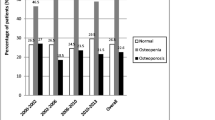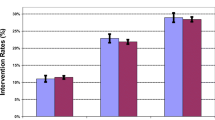Abstract
Summary
Breast cancer survivors are at high osteoporosis risk. Bone mineral density testing plays a key role in osteoporosis management. We analyzed a historical utilization of bone mineral density testing in breast cancer survivors. The utilization remained low in the 1995–2008 period. Lower socio-economic status and rural residency were associated with lower utilization.
Introduction
To evaluate the utilization of bone mineral density (BMD) testing for female breast cancer survivors aged 65+ surviving ≥ 3 years in British Columbia, Canada.
Methods
A retrospecitve population-based data linkage study. Trends in proportion of survivors with ≥ 1 BMD test for each calendar year from 1995 to 2008 were evaluated with a serial cross-sectional analysis. Associations between factors (socio-demographic and clinical) and BMD testing rates over the period 2006–2008 for 7625 survivors were evaluated with a cross-sectional analysis and estimated as adjusted prevalence ratios (PRadj) using log-binomial models.
Results
Proportions of survivors with ≥ 1 BMD test increased from 1.0% in 1995 to 10.1% in 2008. The BMD testing rate in 2006–2008 was 26.5%. Socio-economic status (SES) and urban/rural residence were associated with BMD testing rates in a dose-dependent relationship (p for trend< 0.01). Survivors with lower SES (PRadj = 0.66–0.78) or rural residence (PRadj = 0.70) were 20–30% less likely to have BMD tests, compared with survivors with the highest SES or urban residence. BMD testing rates were also negatively associated with older age (75+) (PRadj = 0.47; 95% CI = 0.42, 0.52), nursing home residency (0.05; 0.01, 0.39), recent osteoporotic fractures (0.21; 0.14, 0.32), and no previous BMD tests (0.26; 0.23, 0.29).
Conclusion
Utilization of BMD testing was low for breast cancer survivors in BC, Canada. Lower SES and rural residence were associated with lower BMD testing rates.
Implication for cancer survivors
Female breast cancer survivors, especially those with lower SES or rural residence, should be encouraged to receive BMD tests as recommended by Canadian guidelines.

Similar content being viewed by others
Abbreviations
- AIs:
-
aromatase inhibitors
- APC:
-
annual percent change
- AAPC:
-
average annual percent change
- BC:
-
British Columbia
- BCCA:
-
British Columbia Cancer Agency
- BCOU:
-
Breast Cancer Outcomes Unit
- BMD:
-
bone mineral density
- CAROC:
-
Canadian Association of Radiologist and Osteoporosis Canada
- DXA:
-
dual-energy X-ray absorptiometry
- FRAX:
-
Fracture Risk Assessment Tool
- ICD:
-
International Classification of Diseases
- MSP:
-
Medical Service Plan
- PCCF:
-
Postal Code Conversion File
- PR:
-
prevalence ratio
- SES:
-
socio-economic status
- STROBE:
-
Strengthening the Reporting of Observational Studies in Epidemiology
- UBC:
-
University of British Columbia
References
Peppone LJ, Mustian KM, Rosier RN, Carroll JK, Purnell JQ, Janelsins MC et al (2014) Bone health issues in breast cancer survivors: a Medicare Current Beneficiary Survey (MCBS) study. Support Care Cancer 22(1):245–251. https://doi.org/10.1007/s00520-013-1967-4
Lustberg MB, Reinbolt RE, Shapiro CL (2012) Bone health in adult cancer survivorship. J Clin Oncol 30(30):3665–3674. https://doi.org/10.1200/JCO.2012.42.2097
Chen Z, Maricic M, Bassford TL, Pettinger M, Ritenbaugh C, Lopez AM et al (2005) Fracture risk among breast cancer survivors—results from the Women’s Health Initiative Observational Study. Arch Intern Med 165(5):552–558. https://doi.org/10.1001/archinte.165.5.552
Harvey N, Dennison E, Cooper C (2010) Osteoporosis: impact on health and economics. Nat Rev Rheumatol 6(2):99–105. https://doi.org/10.1038/nrrheum.2009.260
Tosteson ANA, Melton LJ, Dawson-Hughes B, Baim S, Favus MJ, Khosla S et al (2008) Cost-effective osteoporosis treatment thresholds: the United States perspective. Osteoporosis Int 19(4):437–447. https://doi.org/10.1007/s00198-007-0550-6
Bolland MJ, Grey AB, Gamble GD, Reid IR (2010) Effect of osteoporosis treatment on mortality: a meta-analysis. J Clin Endocrinol Metab 95(3):1174–1181. https://doi.org/10.1210/jc.2009-0852
von Elm E, Altman DG, Egger M, Pocock SJ, Gotzsche PC, Vandenbroucke JP (2007) Strengthening the Reporting of Observational Studies in Epidemiology (STROBE) statement: guidelines for reporting observational studies. BMJ 335(7624):806–808. https://doi.org/10.1136/bmj.39335.541782.AD
British Columbia Cancer Agency [Creator] (2012): BCCA Registry Data. Data Extract. British Columbia Cancer Agency [Publisher]. BC Cancer Agency (2013). http://www.bccancer.bc.ca/
British Columbia Ministry of Health [Creator] (2012): Medical Service Plan (MSP) Payment Information File. Data Extract. Population Data BC [Publisher]. MOH (2013). https://www.popdata.bc.ca/data
Lix LM, Yogendran MS, Leslie WD, Shaw SY, Baumgartner R, Bowman C et al (2008) Using multiple data features improved the validity of osteoporosis case ascertainment from administrative databases. J Clin Epidemiol 61(12):1250–1260. https://doi.org/10.1016/j.jclinepi.2008.02.002
British Columbia Ministry of Health [Creator] (2012): Discharge Abstracts Database (Hospital Separations). Data Extract. Population Data BC [Publisher]. MOH (2013). https://www.popdata.bc.ca/data
Brown JP, Josse RG (2002) 2002 clinical practice guidelines for the diagnosis and management of osteoporosis in Canada. CMAJ 167(10 Suppl):S1–34
British Columbia Ministry of Health [Creator] (2012): Consolidation File (MSP Registration & Premium Billing). Data Extract. MOH. Population Data BC [Publisher]. (2013). https://www.popdata.bc.ca/data
Bilkins R, Khan S (2011) PCCF + Version 5J* User’s Guide Ottawa. Statistics Canada, ON
Statistics Canada. Postal Code Conversion File (PCCF), 2002 Ottawa, Ontario: Statistics Canada Geography Division [Producer and Distributor] 2002. http://datalib.chass.utoronto.ca/codebooks/cstdli/pccf.htm
Quan H, Sundararajan V, Halfon P, Fong A, Burnand B, Luthi JC et al (2005) Coding algorithms for defining comorbidities in ICD-9-CM and ICD-10 administrative data. Med Care 43(11):1130–1139
Statistical Methodology and Applications Branch, Surveillance Research Program, National Cancer Institute. Joinpoint Regression Program, Version 4.3.1.0. April 2016
Barros AJ, Hirakata VN (2003) Alternatives for logistic regression in cross-sectional studies: an empirical comparison of models that directly estimate the prevalence ratio. BMC Med Res Methodol 3:21. https://doi.org/10.1186/1471-2288-3-21
Cancer Surveillance and Outcomes of Population Oncology. BC Cancer Statistics BC Cancer Agency Vancouver, BC 2014. http://www.bccancer.bc.ca/health-info/disease-system-statistics/bc-cancer-statistics/facts-and-figures. Accessed /12/01 2016
Papaioannou A, Morin S, Cheung AM, Atkinson S, Brown JP, Feldman S et al (2010) 2010 clinical practice guidelines for the diagnosis and management of osteoporosis in Canada: summary. CMAJ 182(17):1864–1873. https://doi.org/10.1503/cmaj.100771
Grunfeld E, Dhesy-Thind S, Levine M (2005) Clinical practice guidelines for the care and treatment of breast cancer: follow-up after treatment for breast cancer (summary of the 2005 update). CMAJ 172(10):1319–1320. https://doi.org/10.1503/cmaj.045062
Tenenhouse A, Joseph L, Kreiger N, Poliquin S, Murray T, Blondeau L et al (2000) Estimation of the prevalence of low bone density in Canadian women and men using a population-specific DXA reference standard: the Canadian Multicentre Osteoporosis Study (CaMos). Osteoporos Int 11(10):897–904
Keating NL, Landrum MB, Guadagnoli E, Winer EP, Ayanian JZ (2007) Surveillance testing among survivors of early-stage breast cancer. J Clin Oncol 25(9):1074–1081. https://doi.org/10.1200/Jco.2006.08.6876
Clinical practice guidelines for the diagnosis and management of osteoporosis (1996) Scientific Advisory Board, Osteoporosis Society of Canada. CMAJ 155(8):1113–1133
WHO Study Group on Assessment of Fracture Risk and its Application to Screening for Postmenopausal Osteoporosis (1992 : Rome Italy). Assessment of fracture risk and its application to screening for postmenopausal osteoporosis. WHO technical report series,, vol 843. Geneva: World Health Organization; 1994
World Health Organization. WHO Scientific Group on the Assessment of Osteoporosis at Primary Health Care Level. Summary Meeting Report, Brussels, Belgium, 5–7 May 2004. 2004
Cheung AM, Feig DS, Kapral M, Diaz-Granados N, Dodin S (2004) Prevention of osteoporosis and osteoporotic fractures in postmenopausal women: recommendation statement from the Canadian Task Force on Preventive Health Care. CMAJ 170(11):1665–1667
Cadarette SM, Jaglal SB, Kreiger N, McIsaac WJ, Darlington GA, Tu JV (2000) Development and validation of the osteoporosis risk assessment instrument to facilitate selection of women for bone densitometry. CMAJ 162(9):1289–1294
Siris ES, Chen YT, Abbott TA, Barrett-Connor E, Miller PD, Wehren LE et al (2004) Bone mineral density thresholds for pharmacological intervention to prevent fractures. Arch Int Med 164(10):1108–1112. https://doi.org/10.1001/archinte.164.10.1108
Cranney A, Jamal SA, Tsang JF, Josse RG, Leslie WD (2007) Low bone mineral density and fracture burden in postmenopausal women. Can Med Assoc J 177(6):575–580. https://doi.org/10.1503/cmaj.070234
Siminoski K, Leslie WD, Frame H, Hodsman A, Josse RG, Khan A et al (2005) Recommendations for bone mineral density reporting in Canada. Can Assoc Radiol J 56(3):178–188
Moores DG, Wilson DR, Cave AJ, Woodhead Lyons SC, Donoff MG (2007) Improving the quality and capacity of Canada’s health services: primary care physician perspectives. Healthcare Policy—Politiques de sante, 3 (2):e145–e161
Snyder CF, Frick KD, Peairs KS, Kantsiper ME, Herbert RJ, Blackford AL et al (2009) Comparing care for breast cancer survivors to non-cancer controls: a five-year longitudinal study. J Gen Intern Med 24(4):469–474. https://doi.org/10.1007/s11606-009-0903-2
Schott AM, Ganne C, Hans D, Monnier G, Gauchoux R, Krieg MA et al (2007) Which screening strategy using BMD measurements would be most cost effective for hip fracture prevention in elderly women? A decision analysis based on a Markov model. Osteoporosis Int 18(2):143–151. https://doi.org/10.1007/s00198-006-0227-6
Demeter S, Leslie WD, Lix L, MacWilliam L, Finlayson GS, Reed M (2007) The effect of socioeconomic status on bone density testing in a public health-care system. Osteoporos Int 18(2):153–158. https://doi.org/10.1007/s00198-006-0212-0
Siris ES, Gehlbach S, Adachi JD, Boonen S, Chapurlat RD, Compston JE et al (2011) Failure to perceive increased risk of fracture in women 55 years and older: the Global Longitudinal Study of Osteoporosis in Women (GLOW). Osteoporos Int 22(1):27–35. https://doi.org/10.1007/s00198-010-1211-8
Khatib R, Santesso N, Pickard L, Osman O, Giangregorio L, Skidmore C et al (2014) Fracture risk in long term care: a systematic review and meta-analysis of prospective observational studies. BMC Geriatr 14. https://doi.org/10.1186/1471-2318-14-130
Klotzbuecher CM, Ross PD, Landsman PB, Abbott TA, Berger M (2000) Patients with prior fractures have an increased risk of future fractures: a summary of the literature and statistical synthesis. J Bone Min Res 15(4):721–739. https://doi.org/10.1359/jbmr.2000.15.4.721
Wall M, Lohfeld L, Giangregorio L, Ioannidis G, Kennedy CC, Moser A et al (2013) Fracture risk assessment in long-term care: a survey of long-term care physicians. BMC Geriatr 13:109. https://doi.org/10.1186/1471-2318-13-109
Simonelli C, Killeen K, Mehle S, Swanson L (2002) Barriers to osteoporosis identification and treatment among primary care physicians and orthopedic surgeons. Mayo Clin Proc Mayo Clin 77(4):334–338
Kanis JA, McCloskey EV, Johansson H, Oden A, Strom O, Borgstrom F (2010) Development and use of FRAX in osteoporosis. Osteoporos Int 21(Suppl 2):S407–S413. https://doi.org/10.1007/s00198-010-1253-y
Quan H, Li B, Duncan Saunders L, Parsons GA, Nilsson CI, Alibhai A et al (2008) Assessing validity of ICD-9-CM and ICD-10 administrative data in recording clinical conditions in a unique dually coded database. Health Serv Res 43(4):1424–1441. https://doi.org/10.1111/j.1475-6773.2007.00822.x
Kennecke HF, Ellard S, O'Reilly S, Gelmon KA (2006) New guidelines for treatment of early hormone-positive breast cancer with tamoxifen and aromatase inhitibors. BCMJ 48(3):121–126
Acknowledgements
All inferences, opinions, and conclusions drawn in this report are those of the authors and do not reflect the opinions or policies of the data stewards. The first author, Dr. Olivia L. Tseng, was financially supported by the Clinician Scholarship through the Department of Family Practice of University of British Columbia and Telus-Canadian Breast Foundation National Fellowship.
Funding
This study was supported by a grant from the Canadian Breast Cancer Foundation.
Author information
Authors and Affiliations
Corresponding author
Ethics declarations
Ethical approval
This study has been approved by the University of British Columbia/BC Cancer Agency Ethics Board (H09-01957).
Conflicts of interest
None.
Electronic supplementary material
ESM 1
(DOC 52 kb)
Rights and permissions
About this article
Cite this article
Tseng, O.L., Dawes, M.G., Spinelli, J.J. et al. Utilization of bone mineral density testing among breast cancer survivors in British Columbia, Canada. Osteoporos Int 28, 3439–3449 (2017). https://doi.org/10.1007/s00198-017-4218-6
Received:
Accepted:
Published:
Issue Date:
DOI: https://doi.org/10.1007/s00198-017-4218-6




